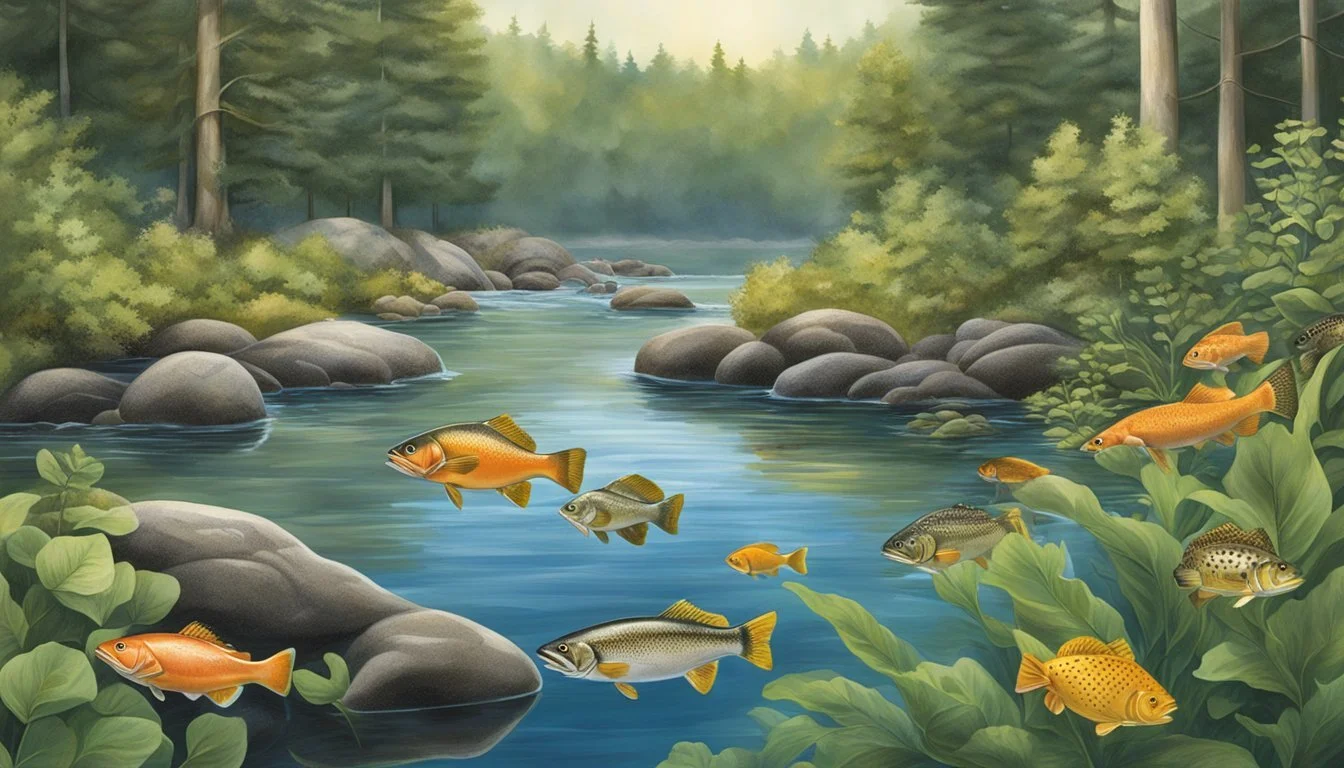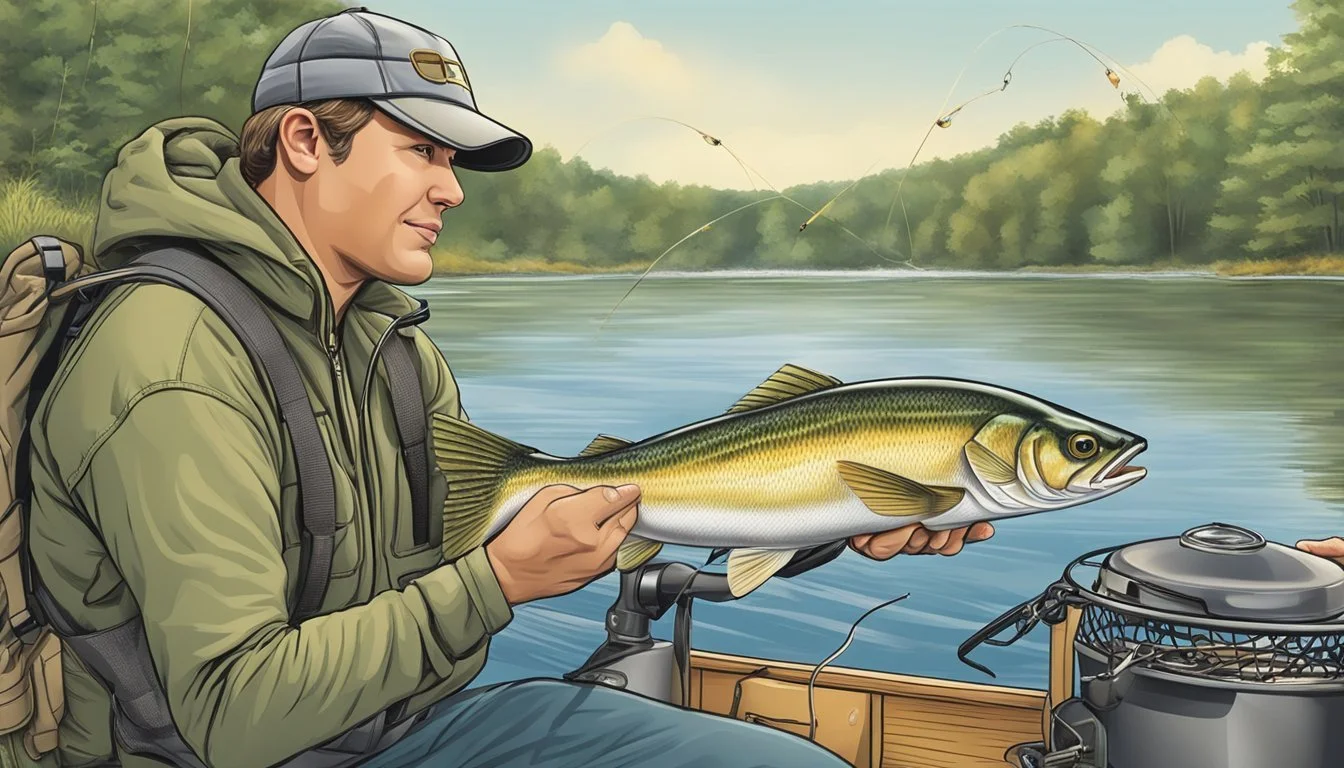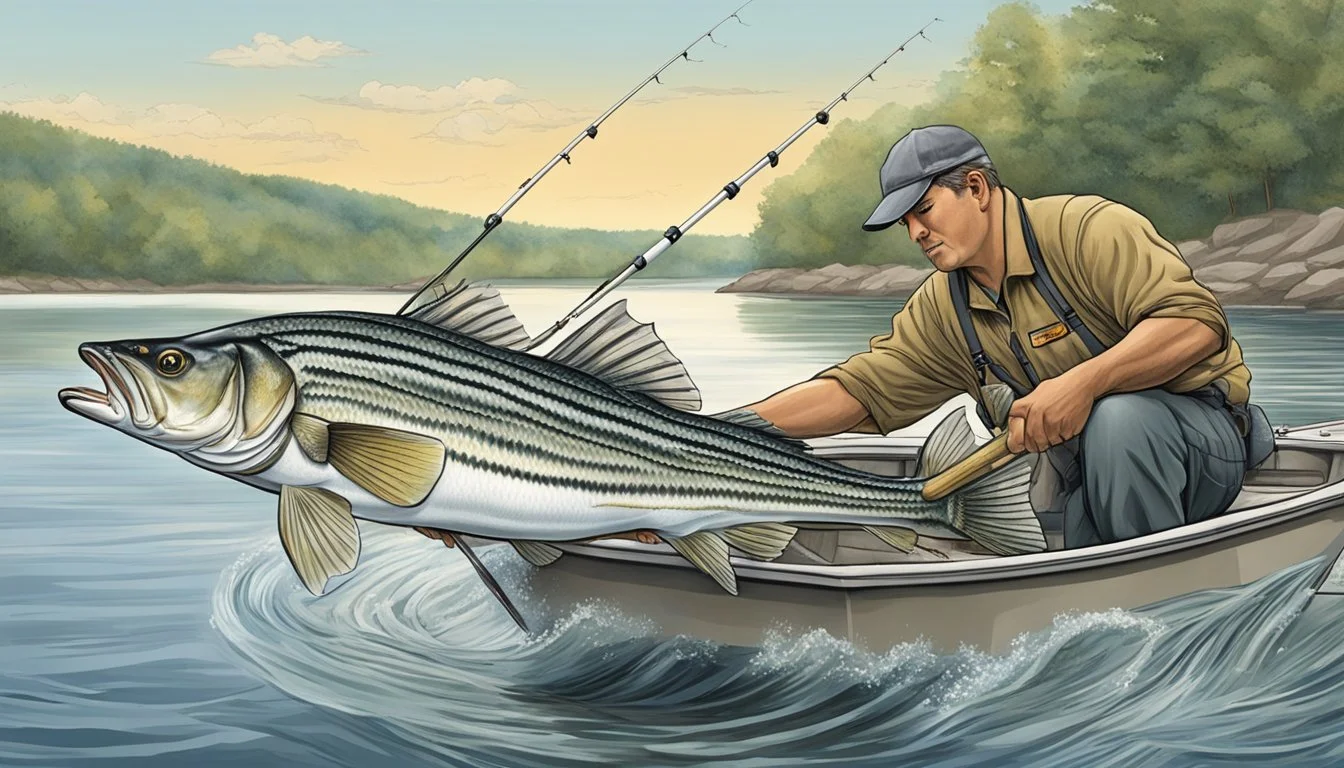Best Fish to Catch and Eat in Connecticut
Your Ultimate Guide
Connecticut offers a rich array of freshwater and saltwater fishing spots teeming with fish (What wine goes well with fish?) varieties perfect for both sport and supper. With its extensive shoreline and numerous lakes and rivers, the state presents anglers with abundant opportunities to reel in popular species like Striped Bass, known for their spawning runs in freshwater rivers during spring and early fall. These migratory fish are not only a challenge to hook but are also prized for their taste, making them a top catch among Connecticut's fishing community.
In addition to Striped Bass, Connecticut's waters are home to diverse fish species that appeal to anglers for their culinary qualities. The state issues advisories to ensure that fish caught are safe to eat, addressing concerns around contaminants such as PFOS and Mercury. Fish such as the Brown Bullhead, Sunfish, and Largemouth Bass are not only commonly found but offer a delightful experience for those looking to unhook a meal. Their presence in places like the Connecticut River, which accounts for a significant portion of the freshwater input to Long Island Sound, underscores the river's role as a vital fishing hub.
While fishing is a beloved pastime in Connecticut, it's imperative for anglers to be aware of conservation efforts and regulations in place. For instance, Atlantic Salmon are managed carefully, with stipulations to release them immediately unless caught in designated areas. These regulations help maintain sustainable fish populations and protect the health of the aquatic ecosystems, ensuring that fishing enthusiasts can enjoy the thrill of the catch and the feast that follows for years to come.
Fishing in Connecticut
Connecticut offers a rich tapestry of fishing experiences, ranging from the tranquil freshwater rivers and lakes to the dynamic marine environments along its coast. The Constitution State is increasingly regarded as a prime destination for anglers looking for diverse fishing opportunities.
Freshwater Fishing Connecticut lakes and rivers are bountiful with species such as Bass, Northern Pike, and Walleye. Notably, Candlewood Lake in Litchfield County is not only the largest lake in the state but also an excellent spot for angling. Engineered in the 1920s for hydroelectric power, it now serves as a popular fishing location.
Saltwater Fishing Connecticut's coastline provides ample saltwater fishing opportunities. Anglers might target species such as Bluegill, Channel Catfish, and Sunfish off the piers or head into deeper waters in pursuit of larger game.
Species to Catch Here is a list of some sought-after fish in Connecticut's waters:
Freshwater
Bass (Largemouth and Smallmouth)
Northern Pike
Walleye
Saltwater
Bluegill
Channel Catfish
Sunfish
Advisory Information Anglers should be aware of the CT Fish Consumption Advisory, which provides up-to-date recommendations on safe fish consumption practices. The focus is on maintaining health benefits while mitigating potential contaminants.
Whether for sport or sustenance, fishing in Connecticut is an activity that respects both nature and tradition. The state's blend of freshwater and saltwater environments ensures that whether one is angling for relaxation or competition, the experience is profound and rewarding.
Key Fish Species in Connecticut Waters
Connecticut offers a diverse range of fish species in its waters, both freshwater and marine. Anglers can expect to encounter a variety of fish that are ideal for both recreational fishing and culinary enjoyment. Careful attention to sustainability and local consumption advisories ensures a responsible and rewarding fishing experience.
Saltwater Fish
Bluefish - Known for their fighting spirit, bluefish are common in Connecticut's coastal waters. They offer a strong flavor and can be grilled, baked, or smoked.
Flounder - Flounder, particularly the summer flounder or fluke, are well-liked for their delicate, white meat. This bottom-dwelling fish is often found in sandy habitats.
Porgy - Also known as scup, porgy is a popular catch due to its sweet taste and firm texture, making it excellent for a variety of cooking methods.
Tuna (What wine goes well with tuna?) - While not as common inshore, several species of tuna can be caught off Connecticut's coast, offering a prized culinary experience for those willing to venture farther out to sea.
Shellfish (What wine goes well with shellfish?) - Lobster, blue crab (how long does crab last?), oysters, scallops (What wine goes well with scallops?), mussels, and clams (how long do clams last?) provide an abundance of options for seafood enthusiasts. Local regulations help maintain sustainable populations.
Freshwater Fish
Bass
Largemouth Bass - A popular choice for anglers, largemouth bass can reach substantial sizes and are a delight when fried or grilled.
Smallmouth Bass - These fish are often found in cooler waters with rocky substrates and are known for their vigorous fight.
Trout
Rainbow Trout - Identified by the dark spots on their head and tail, rainbow trout are a stocking staple and sought after for their flavor.
Brown Trout and Brook Trout - Both species are native and present in rivers and streams, offering a classic angling challenge and delightful taste.
Catfish - Inhabiting many of Connecticut's rivers and ponds, catfish are a hearty option for a filling meal, often prepared through baking or frying.
Pike and Pickerel - These predatory fish provide an exciting catch and are most often caught using lures that mimic smaller prey.
Yellow Perch - A favored panfish due to its white flaky meat, perch are commonly caught by ice fishing during winter months.
White Perch - Easily recognized by its silver body, white perch are smaller than yellow perch but similarly appreciated for their taste.
Prime Fishing Locations
Connecticut offers a diverse range of environments for anglers, from the brackish waters of the Long Island Sound with an array of coastal species to the freshwater catches in the rivers and lakes inland.
Long Island Sound
Long Island Sound is a premier coastal fishing destination. Anglers will find Striped Bass, highly sought after both for their fighting spirit and taste, plentiful in these waters. In addition to bass, fishermen may also reel in Flounder and Bluefish, making it a versatile spot for those seeking a variety of saltwater species.
Connecticut River
The Connecticut River is the longest river in New England, brimming with Catfish, Pike, and Bass, perfect for sport fishing and consumption. Its expansive watershed also connects smaller tributaries such as the Salmon River and Farmington River which further enrich the area's biodiversity.
Notable Tributaries:
Salmon River: Recognized for its trout.
Farmington River: Offers a mix of trout and other freshwater game.
Inland Lakes and Rivers
Connecticut's inland water bodies are stocked with a variety of fish. Candlewood Lake, the state's largest, is a hotspot for Bass and Walleye. Smaller options like Bantam Lake and the Saugatuck Reservoir present tranquil settings with a similar diversity.
Inland Fishing Spots:
Housatonic River: Notable for trout and smallmouth bass.
Saugatuck River: Smallmouth bass and trout can be found.
Bantam Lake & Lillinonah: Home to a range of fish including bass.
Quinnipiac and Naugatuck Rivers: Good for trout and other freshwater species.
Pequabuck River: Though smaller, it is a suitable spot for local anglers.
This concise overview leads anglers to the prime locations in Connecticut for both the pursuit of the catch and the enjoyment of the table. Whether fishing along the coastline or inland, one can find spots teeming with preferred species.
Fishing Seasons and Timing
Connecticut offers a diverse fishing calendar, with specific seasons dictating the best times to catch various species. Anglers should be mindful of these timeframes to optimize their fishing outings.
Open Season
April marks a significant month in Connecticut's fishing calendar, as many fishing seasons commence during this period. Ice fishing typically ends as the climate warms, and the waters open up for traditional angling methods. By the second Saturday in April, anglers eagerly welcome the start of the fishing season for Trout and other freshwater varieties.
Stocked Fisheries: The state actively stocks water bodies to enhance fishing experiences, with ideal conditions arriving in May and extending into June. These months also see robust fish activity as the spawning season is in full swing for many species.
Summertime:
Trout: Optimal early in the morning or late in the evening to avoid the heat.
Bass & Pike: Fishing can be rewarding throughout the day.
Table 1: Key Open Season Dates for Popular Species
Species Open Season Start Note Trout April (second Saturday) Peak season after stocking events Bass June 1st Anglers should check for specific lake regulations Pike April (second Saturday) Considered prime time as waters warm
Off-Peak Season
The Off-Peak Season, typically seen in the colder months like January and March, is characterized by a dramatic decrease in fishing activities. However, anglers can still engage in ice fishing where conditions permit, targeting species that are active during these colder months.
January:
Trout: Available through ice fishing in select locations, with the Housatonic River being a notable spot for winter fly-fishing.
March:
Represents a transitional period as ice fishing concludes and waters begin to thaw. Certain areas mandate Catch and Release only until the official season opens in April.
Table 2: Fishing Considerations During Off-Peak Season
Month Activity Type Considerations January Ice fishing Brown trout in the Housatonic River March Catch & Release Preparing for the open season in April
Fishing Licenses and Regulations
In Connecticut, recreational fishing mandates adherence to certain rules and licenses set forth by regulatory bodies. Anglers aged 16 or older targeting marine species from the shore or a boat need to secure a Marine Waters Fishing License. Licenses align with the calendar year, expiring on December 31st.
The Connecticut Department of Energy & Environmental Protection (DEEP) partners with eRegulations to provide up-to-date guides and the conditions for fishing within the state. Licensed anglers must follow these regulations, which are accessible via the CT.gov server or through the mobile app, which is free for users.
Additionally, the Connecticut Department of Public Health, in collaboration with DEEP, issues consumption advisories, particularly relevant when considering species with potential contaminants like lead or mercury. Such information is crucial for those who fish not only for sport but also intend to consume their catch.
License Type Required For Where to Obtain Marine Waters Fishing License Anglers 16+ fishing marine district or landing marine fish/species CT.gov or approved license vendors
Before partaking in fishing activities, it's imperative to review the full legal text of the Regulations and State Statutes for compliance. Furthermore, for those who are interested in the "catch and consumption" aspect of fishing, staying informed about the consumption advisories for certain fish species is important for health and safety.
Anglers are encouraged to familiarize themselves with the annual advisories and are reminded to practice responsible fishing, aligning with environmental conservation efforts and public health guidelines.
Environmental Protection and Species Preservation
The Connecticut Department of Public Health, alongside the Department of Energy & Environmental Protection, plays a pivotal role in safeguarding both public health and the state’s aquatic ecosystems. These agencies enforce regulations to ensure the sustainable practice of sport fishing, aligning with efforts to preserve Connecticut’s natural heritage.
With a focus on promoting safe fish consumption, these departments provide guidelines to mitigate health risks associated with pollutants such as mercury. Mercury exposure is a primary concern; it can accumulate in fish in varying degrees, potentially impacting human health.
Species Monitoring: The authorities conduct regular assessments of fish species to determine the safety of consumption. Anglers are advised to follow these guidelines rigorously:
Mercury Levels: Choose fish with lower mercury content, especially for pregnant women and children.
Sport Fish: Be aware of size and possession limits to support species sustainability.
Best Practices for Anglers:
Catch and Release: Practice catch and release for species that are under advisory.
Clean and Cook: Properly cleaning and cooking fish can reduce exposure to certain contaminants.
Health Advisory Updates: These departments release annual advisories, ensuring the public is informed on the current status of local fish populations. The advisories include species-specific consumption guidelines to minimize risk from contaminants like mercury, PFOS, and PCBs.
It is essential that both anglers and consumers stay informed through reliable resources provided by these departments, as preserving Connecticut’s waterways and fish populations is a shared responsibility. Adherence to these guidelines ensures that sports fishing can be enjoyed by future generations while protecting the environmental balance.
Fishing Techniques and Equipment
When targeting the diverse fish species in Connecticut, anglers must choose suitable techniques and equipment. The tactics vary significantly between freshwater, saltwater, and ice fishing scenarios.
Freshwater Fishing Techniques
Fly Fishing: Fly fishing in Connecticut is especially effective for catching trout and salmon in rivers like the Housatonic. Anglers typically use hand-tied flies that mimic local insects or baitfish. It requires a specific set of gear including a fly rod, reel, specialized line, and leaders.
Angling: For species such as the Brown Trout and Bass, traditional angling with spinning or casting rods is popular. Anglers may employ various lures or live bait depending on the time of year and target species. The Brown Trout often responds well to small spinners or live worms, while largemouth bass in locales like Candlewood Lake are susceptible to crankbaits and rubber swimbaits.
Saltwater Fishing Techniques
Trolling: Trolling is a method where one draws lures or baited hooks behind a moving boat. In Connecticut's coastal waters, trolling can be an effective way to catch Striped Bass and Bluefish. Anglers must adjust the depth and speed based on the behavior of the fish and the conditions.
Bottom Fishing: Even during the offseason for saltwater fishing, enthusiasts can catch species such as Cod by focusing on bottom fishing techniques, which involve weighting a baited hook to the seafloor.
Ice Fishing Techniques
Ice Fishing: During the winter months, ice fishing becomes a prevalent activity. Anglers use augers to drill through the ice and set up their spots with small, lightweight gear. Use of live baits like shiners or mealworms, as well as jigs, can be effective under the ice. They often employ portable shelters to stay warm and can detect bites using simple hand-held rods or tip-ups, which signal when a fish has taken the bait.
Fishing Tips and Best Practices
When pursuing the best fish to catch and eat in Connecticut, anglers should adhere to some effective fishing tips and best practices.
Gear and Tactics
Rod and Reel: It's imperative to match the rod and reel to the species targeted. For instance, a medium-action rod is suitable for fluke.
Bait: Utilize fresh, local bait. Crayfish are excellent for largemouth bass, while live baits like worms work well for trout.
Timing
Seasons: Fish are most active during early morning and late evening, particularly in summer and fall. Fluke, for instance, is best caught in late spring and summer.
Weather: Overcast skies can often lead to productive fishing outings, as fish feel secure and more willing to feed.
Regulations
Anglers must stay informed about local fishing regulations to ensure sustainable practices:
Sizes and Limits: Adhere to size and catch limits.
License: Possess a current fishing license as required.
Location
Rivers and Lakes: Research has shown that rivers like the Farmington provide extensive fishing opportunities due to their length and diverse habitats.
Hotspots: Identifying underwater structures and changes in depth can be crucial for locating fish.
Conservation
Catch and Release: Practice catch and release when possible, especially for species that are not intended for consumption.
Habitat: Respect the fishing environment by leaving no trace and preserving the natural habitat for fish populations.
By following these tips and practices, anglers can enhance their fishing experience and contribute to the conservation of Connecticut’s aquatic ecosystems.
Catch and Consumption Safety
When venturing out to catch fish in Connecticut's waters, anglers should be informed about safety concerns regarding the consumption of their catch. The Connecticut Department of Public Health, in collaboration with the Department of Energy & Environmental Protection, provides guidelines to ensure that the fish you consume are safe and healthy.
Fish Advisory: Due to contaminants like mercury and polychlorinated biphenyls (PCBs), certain fish are subjected to consumption advisories. Predatory fish such as striped bass and bluefish, which are popular among recreational fishers, tend to have higher levels of mercury. The same considerations apply to tuna and shark.
Mercury Awareness: Mercury is a concern specifically for pregnant women and young children due to its negative effects on development. As a rule, they should limit their intake of freshwater fish to one meal per month. It's prudent for all anglers to consult the latest advisories for specific water bodies and fish species before consumption.
Shellfish Safety: When it comes to shellfish like oysters, clams, scallops, and mussels, they can be safer options as they are generally lower in mercury. However, local advisories may still apply, especially in areas affected by pollutants or red tide blooms.
High-Risk Species Moderate-Risk Species Lower-Risk Species Shark Striped Bass Trout Tuna Bluefish Sunfish Scup (Porgy)
Note: The emphasis should always be on checking with state advisories for updates and guidelines to safeguard against the risks associated with consuming fish from local waters.
Events and Competitions
In Connecticut, angling competitions and events are a testament to the state's thriving fishing culture. Enthusiasts can engage in a variety of tournaments that highlight the abundance and variety of fish available.
The Connecticut Rivers Anglers Tournament, held annually, invites anglers to compete in catching the largest examples of various species.
The Annual Bluefish Tournament, typically occurs in the summer, drawing both seasoned and novice fishermen.
Participants in these events often target species known for both their fight and flavor, such as Striped Bass and Bluefish. These tournaments not only encourage sportsmanship but also focus on sustainable fishing practices.
For those interested in friendly competition or community involvement, local fishing clubs and organizations arrange contests throughout the year that cater to different age groups and skill levels. They may include:
Fly fishing competitions in renowned trout streams.
Ice fishing derbies during the winter season, which is particularly noteworthy in the northern parts of the state.
Specific dates and rules for these events can vary, with details usually available on the organizers' websites or through fishing communities. Anglers are encouraged to participate, not just for the competition, but also to experience the camaraderie and shared knowledge these gatherings offer.








